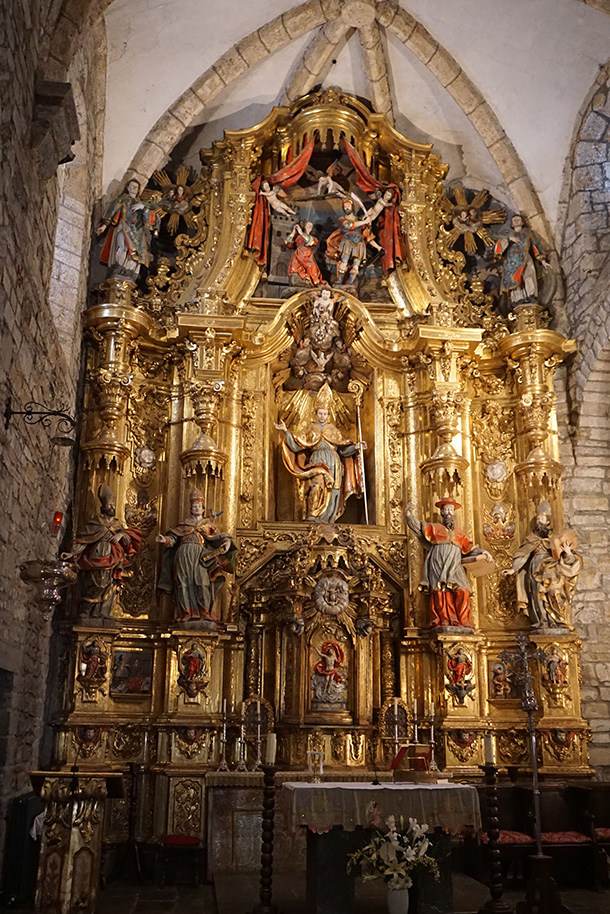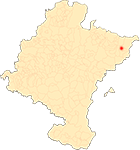Route through the Roncal altarpieces
By Ricardo Fernández Gracia
High altarpiece of the parish church of Urzainqui
This altarpiece is the work of the second of the Pejón family, Nicolás Francisco Pejón Lizuáin (1725-c.1781), son of the master architect Francisco Pejón, who also lived in Sos del Rey Católico and was active in Navarre at the end of the 1930s and the beginning of the following decade. Nicolás Francisco Pejón carried out various works in Navarre between 1753 and 1772, and was examined in Sangüesa to be able to practice his official documentwithout restrictions in 1760, becoming positionof numerous important projects in Sangüesa, the Roncal Valley (Urzainqui, Garde, Roncal and Burgui) and in the Comendadoras de Puente la Reina.
The first documented altarpiece in Navarre by this master is the main altarpiece in Urzainqui. It was commissioned in March 1753 and, once again, it was the fashions and the state of the old altarpiece that led the local residents to apply forto obtain permission from the Provisor of the Bishopric of Pamplona to commission a new altarpiece. The cost, including the imagery, amounted to 1,000 pesos. The gilding of the altarpiece was carried out by Andrés Mata in 1768.
The altarpiece occupies the entire chancel of the parish church of San Martín and is a great machine whose model, of Aragonese lineage, is completely innovative in this part of Navarre. Its great novelty lies in the replacement of the supports by statues with colourful canopies that give way to the capitals. Its plan, adapted to the flat chevet of the church, obtains movement through the juxtaposition of curved and straight elements, giving rise to a rich mixtilinear design. In its elevations there is a pedestal with decorative rockery panels and a bench with seraphim plaques on its fronts, on which four pedestals are mounted. On them rest four monumental sculptures of the Fathers of the Church, which serve as the giant order. The attic culminates in a moving baldachin, from which hangs glued cloths and is flanked by curved machones, rocaille plaques and baroque glories. The tabernacle-exhibitor is a contemporary piece, in the form of a central temple on a pedestal with plaques, which extends in counter-curves to join the Structuresof the altarpiece.
The iconographic speechis abundant and respects the agreement between the patrons of the parish and the sculptor. The rich programme begins with the reliefs of the evangelists attached to the pedestals, with scenes from the life of Saint Martin between them. The four Fathers of the Church accompany the patron saint, two on each side, in the main body. In the attic, under the canopy, is the martyrdom of Saint Barbara and on either side are the holy deacons, Saint Vincent and Saint Lawrence. All the sculptures are of Aragonese origin. They are life-size figures with highly characterised faces and garments with pompous folds, inspired by the Holy Fathers and Apostles made at that time by the great sculptor José Ramírez. The polychromy of the altarpiece is very rich, contrasting the colourful vestments of the saints with the golden backgrounds of the enormous architectural machine.
Parish archives of Garde, Vidángoz, Isaba, Uztárroz and Roncal.
file Diocesan of Pamplona. Processes
file General of Navarre. Roncal Notary's Office and Processes
ARDANAZ IÑARGA, N., La catedral de Pamplona en el siglo de las Luces. Arte, ceremonial y cultura, Pamplona, doctoral dissertation sustained at the University of Navarre, 2011. Vid. http://hdl.handle.net/10171/20480
BOLOQUI LARRAYA, B., Escultura zaragozana en la época de los Ramírez 1710-1780, Madrid, Ministerio de Cultura, 1983.
CHOCARRO HUESA, M., "El obispo Juan Rena, mediador y mecenas artístico de la catedral de Pamplona", Príncipe de Viana, 256 (2012), Issue dedicated to: programs of study sobre el Patrimonio Cultural y las artes en Navarra en torno a tres hitos 1212-1512-1812, (coordinated by Ricardo Fernández Gracia), pp. 587-601.
CLAVERÍA ARANGUA, J., Iconografía y santuarios de la Virgen en Navarra, vol. I, Madrid, Gráfica management assistant, 1942.
ECHEVERRÍA GOÑI, P., Polychromy of the Renaissance in Navarre, Pamplona, Government of Navarre, 1990.
GARCÍA GAÍNZA, M. C., Romanesque sculpture in Navarre. Disciples and followers of Juan de Anchieta, Pamplona, 1969.
GARCÍA GAÍNZA, M. C. et alt., Catalog Monumental de Navarra, IV* y IV**. Merindad de Sangüesa, Pamplona, Government of Navarra - Archbishopric of Pamplona - University of Navarra, 1989 and 1992.
FERNÁNDEZ GRACIA, R., El retablo barroco en Navarra, Pamplona, Government of Navarre, 2003.
FERNÁNDEZ GRACIA, R., "Los géneros escultóricos", El arte del Barroco en Navarra, (coord. R. Fernández Gracia), Pamplona, Gobierno de Navarra, 2014, pp. 175-271.
GÁRRIZ, J., La villa de Garde en el Valle del Roncal. essay de una monografía parroquial, Pamplona, Casa publishing house de G. Huarte, 1923.
HUALDE, F., "De cuando los Ezquer cruzaron el charco", Diario de Noticias de Navarra, 18 August 2008. http://patrimonionavarra2.blogspot.com.es/2010/09/18-de-agosto-de-2008.html
MORALES SOLCHAGA, E., "El gremio de San José y Santo Tomás de Pamplona hasta el siglo XVII", Príncipe de Viana, no. 239 (2006), pp. 791-860.
URANGA, J. E., Retablos navarros del Renacimiento, Pamplona, Institución Príncipe de Viana, 1947.












